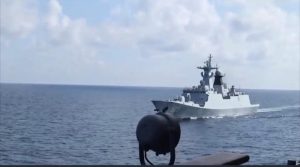The Chinese equivalent to the Western notion of “salami-slicing” tactics is the idea of “silkworm eating” (蚕食). This colloquialism for gradual encroachments traces its origins to the State of Qin’s consolidation tactics. The essence is gaining success by slowly making inroads, by nibbling away at something.
China employs a silkworm-eating strategy against Taiwan today. The almost-daily People’s Liberation Army (PLA) incursions into the Taiwan Air Defense Identification Zone (TADIZ) and major exercises in response to political events are well documented. Most likely, these sorties seek to demonstrate capabilities, erode Taiwanese sovereignty, and challenge the legitimacy of the TADIZ. Recurring penetrations normalize PLA air operations around Taiwan, while forcing Taiwan to expend finite military resources (aircraft and pilot hours) in response.
Much less reporting in the media describes the daily surface force operations around Taiwan, which is also a key component of the silkworm-eating strategy.
Since August 5 of last year, Taiwan’s Ministry of National Defense has publicly reported on PLA Navy (PLAN) surface operations around Taiwan. Based on that data, the PLAN has maintained an average combatant presence of just over four (4.24) around Taiwan through to April 11, 2023.
Assuming Taiwan’s Defense Ministry directs a 1:1 shadow of PLAN combatants, the Republic of China Navy (ROCN) must keep at least 15 percent of its destroyers and frigates at sea, reacting to PLAN forces alone. Forcing Taiwan to expend naval resources (at-sea days and operational tempo) achieves an effect on Taiwan’s navy, analogous to the impact of China’s regular TADIZ incursions on Taiwan’s air force.
These operations look set to continue as the ROCN modernizes and the PLAN reorganizes its surface forces. Taiwan’s navy plans to spend $1.37 billion to upgrade its six Kang Ding (Lafayette) frigates over the next seven years. The first Kang Ding frigate should enter its upgrade availability by the middle of 2023 and finish sometime in the latter part of the year.
Meanwhile, the PLAN is strengthening frigate detachments by replacing smaller combatants with more capable ones. An example is the two detachments homeported in Fujian province along the Taiwan Strait, as part of the reorganization. Twenty-two Type 056 (Jiangdao-class) corvettes from frigate detachments were retired and transferred to the China Coast Guard during 2021-2022. Replacing them are Type 054 (Jiangkai) frigates, which provide the required “practical improvements in the ability to perform combatant missions in the offshore waters.”
The PLAN is assigning at least some of its older Jiangkai frigates from destroyer flotillas to frigate detachments as the newer and larger Type 054B (Jiangkai-III) frigates and additional destroyers enter service. The reassignment increases the frigate detachments’ and destroyer flotillas’ multiwarfare domain capabilities, while likely freeing up pier space at major naval facilities. China’s Eastern Theater Navy (ETN) reassigned both Type 054s to the 15th Frigate Detachment at Sandu. Concurrently, the ETN assigned one and likely even a second of its newest Type 054A (Jiangkai-II) frigates to the 16th Frigate Detachment at Xiamen.
Stationing the frigates in Fujian likely improves the ETN’s mobility and maneuvers for its operations around Taiwan. Homeported within hours of Taiwan’s sea lines of communication (SLOCs), the frigates have the mobility capacity “to operate at length, up to months on or near station.” This capability helps mitigate Taiwan’s previous proximity advantage. Additionally, the frigates enable fleet maneuver by increasing decision space through agility and immediacy. Both improvements are likely key to boosting the ETN’s employment of the silkworm-eating strategy. ETN could now potentially use these frigates (equal to 15 percent of ROCN frigates and destroyers) to simultaneously react to a Taiwan Strait transit and rapidly increase its presence in Taiwan’s SLOCs, forcing Taiwan to react.
The more capable Fujian detachments will also likely provide the ETN with operational flexibility in assigning force to offshore and far-sea missions during a Taiwan contingency. These multi-mission combatants and their proximity have the potential to rapidly transition from offshore surface warfare to far-sea anti-submarine operations as part of comprehensive sea area control if required.
Further assignment of Type 054As to frigate detachments is possible, as multiple new Type 054As and Type 054Bs will enter service over the next several years. These assignments, even if temporary, only enhance the ETN’s ability to concentrate force and take advantage of a situation expeditiously. Additional surface forces in Fujian likely will result in additional presence and a nibbling away at Taiwan naval resources just as the Ministry of National Defense tries to modernize its force.































